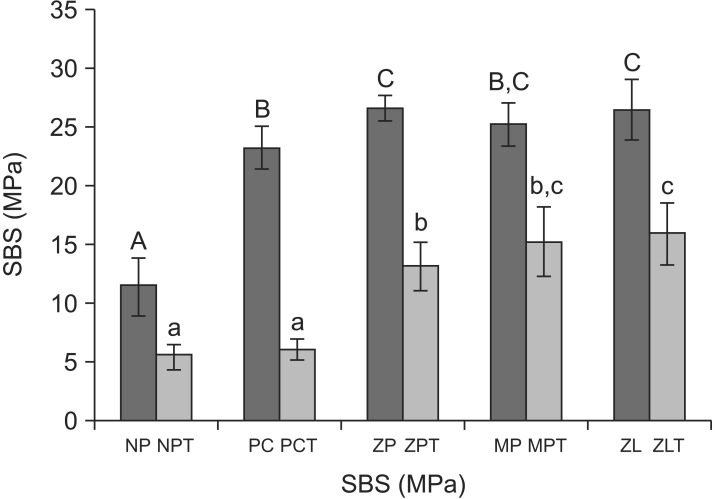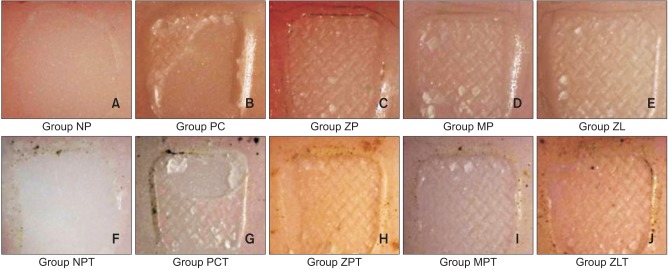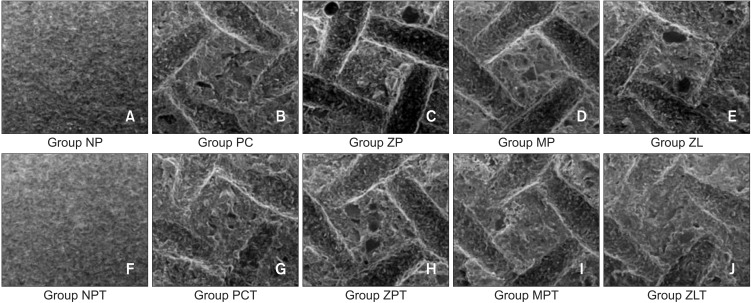Korean J Orthod.
2015 Jul;45(4):164-170. 10.4041/kjod.2015.45.4.164.
Comparison of shear bond strength of orthodontic brackets using various zirconia primers
- Affiliations
-
- 1Department of Orthodontics, National Health Insurance Corporation Ilsan Hospital, Goyang, Korea.
- 2Department of Orthodontics, The Institute of Craniofacial Deformity, College of Dentistry, Yonsei University, Seoul, Korea. hwang@yuhs.ac
- KMID: 2400574
- DOI: http://doi.org/10.4041/kjod.2015.45.4.164
Abstract
OBJECTIVE
The aim of this study was to compare the shear bond strength (SBS) of orthodontic brackets bonded to zirconia surfaces using three different zirconia primers and one silane primer, and subjected to thermocycling.
METHODS
We designed 10 experimental groups following the surface treatment and thermocycling. The surface was treated with one of the following method: no-primer (NP), Porcelain Conditioner (PC), Z-PRIME Plus (ZP), Monobond Plus (MP) and Zirconia Liner Premium (ZL) (n=20). Then each group was subdivided to non-thermocycled and thermocycled groups (NPT, PC, ZPT, MPT, ZLT) (n=10). Orthodontic brackets were bonded to the specimens using Transbond(TM) XT Paste and light cured for 15 s at 1,100 mW/cm2. The SBS was measured at a 1 mm/min crosshead speed. The failure mode was assessed by examination with a stereomicroscope and the amount of bonding resin remaining on the zirconia surface was scored using the modified adhesive remnant index (ARI).
RESULTS
The SBS of all experimental groups decreased after thermocycling. Before thermocycling, the SBS was ZL, ZP > or = MP > or = PC > NP but after thermocycling, the SBS was ZLT > or = MPT > or = ZPT > PCT = NPT (p > 0.05). For the ARI score, both of the groups lacking primer (NP and NPT) displayed adhesive failure modes, but the groups with zirconia primers (ZP, ZPT, MP, MPT, ZL, and ZLT) were associated with mixed failure modes.
CONCLUSIONS
Surface treatment with a zirconia primer increases the SBS relative to no-primer or silane primer application between orthodontic brackets and zirconia prostheses.
MeSH Terms
Figure
Cited by 3 articles
-
Comparison of the bonding strengths of second- and third-generation light-emitting diode light-curing units
Hee-Min Lee, Sang-Cheol Kim, Kyung-Hwa Kang, Na-Young Chang
Korean J Orthod. 2016;46(6):364-371. doi: 10.4041/kjod.2016.46.6.364.Comparison of bond strengths of ceramic brackets bonded to zirconia surfaces using different zirconia primers and a universal adhesive
Ji-Yeon Lee, Jaechan Ahn, Sang In An, Jeong-won Park
Restor Dent Endod. 2018;43(1):e7. doi: 10.5395/rde.2018.43.e7.Comparison of bond strengths of ceramic brackets bonded to zirconia surfaces using different zirconia primers and a universal adhesive
Ji-Yeon Lee, Jaechan Ahn, Sang In An, Jeong-won Park
Restor Dent Endod. 2018;43(1):. doi: 10.5395/rde.2018.43.e7.
Reference
-
1. Kokich VG, Spear FM. Guidelines for managing the orthodontic-restorative patient. Semin Orthod. 1997; 3:3–20. PMID: 9206469.2. Wood DP, Jordan RE, Way DC, Galil KA. Bonding to porcelain and gold. Am J Orthod. 1986; 89:194–205. PMID: 2937306.
Article3. Ortorp A, Kihl ML, Carlsson GE. A 3-year retrospective and clinical follow-up study of zirconia single crowns performed in a private practice. J Dent. 2009; 37:731–736. PMID: 19564070.4. Raigrodski AJ, Chiche GJ, Potiket N, Hochstedler JL, Mohamed SE, Billiot S, et al. The efficacy of posterior three-unit zirconium-oxide-based ceramic fixed partial dental prostheses: a prospective clinical pilot study. J Prosthet Dent. 2006; 96:237–244. PMID: 17052467.
Article5. Guess PC, Zavanelli RA, Silva NR, Bonfante EA, Coelho PG, Thompson VP. Monolithic CAD/CAM lithium disilicate versus veneered Y-TZP crowns: comparison of failure modes and reliability after fatigue. Int J Prosthodont. 2010; 23:434–442. PMID: 20859559.6. Zhang Y, Chai H, Lee JJ, Lawn BR. Chipping resistance of graded zirconia ceramics for dental crowns. J Dent Res. 2012; 91:311–315. PMID: 22232142.
Article7. Miyazaki T, Nakamura T, Matsumura H, Ban S, Kobayashi T. Current status of zirconia restoration. J Prosthodont Res. 2013; 57:236–261. PMID: 24140561.
Article8. Wolf DM, Powers JM, O'Keefe KL. Bond strength of composite to etched and sandblasted porcelain. Am J Dent. 1993; 6:155–158. PMID: 8240779.9. Kato H, Matsumura H, Atsuta M. Effect of etching and sandblasting on bond strength to sintered porcelain of unfilled resin. J Oral Rehabil. 2000; 27:103–110. PMID: 10672145.
Article10. Kitayama S, Nikaido T, Takahashi R, Zhu L, Ikeda M, Foxton RM, et al. Effect of primer treatment on bonding of resin cements to zirconia ceramic. Dent Mater. 2010; 26:426–432. PMID: 20102781.
Article11. Kern M, Barloi A, Yang B. Surface conditioning influences zirconia ceramic bonding. J Dent Res. 2009; 88:817–822. PMID: 19767578.
Article12. Magne P, Paranhos MP, Burnett LH Jr. New zirconia primer improves bond strength of resin-based cements. Dent Mater. 2010; 26:345–352. PMID: 20047757.
Article13. Atsu SS, Kilicarslan MA, Kucukesmen HC, Aka PS. Effect of zirconium-oxide ceramic surface treatments on the bond strength to adhesive resin. J Prosthet Dent. 2006; 95:430–436. PMID: 16765155.
Article14. Artun J, Bergland S. Clinical trials with crystal growth conditioning as an alternative to acid-etch enamel pretreatment. Am J Orthod. 1984; 85:333–340. PMID: 6231863.15. Kern M, Wegner SM. Bonding to zirconia ceramic: adhesion methods and their durability. Dent Mater. 1998; 14:64–71. PMID: 9972153.
Article16. Reynolds I. A review of direct orthodontic bonding. Br J Orthod. 1975; 2:171–178.
Article17. McCarthy MF, Hondrum SO. Mechanical and bond strength properties of light-cured and chemically cured glass ionomer cements. Am J Orthod Dentofacial Orthop. 1994; 105:135–141. PMID: 8311035.
Article18. Chen L, Suh BI, Brown D, Chen X. Bonding of primed zirconia ceramics: evidence of chemical bonding and improved bond strengths. Am J Dent. 2012; 25:103–108. PMID: 22779284.19. Lorenzoni FC, Leme VP, Santos LA, de Oliveira PC, Martins LM, Bonfante G. Evaluation of chemical treatment on zirconia surface with two primer agents and an alkaline solution on bond strength. Oper Dent. 2012; 37:625–633. PMID: 22433034.
Article20. Blatz MB, Chiche G, Holst S, Sadan A. Influence of surface treatment and simulated aging on bond strengths of luting agents to zirconia. Quintessence Int. 2007; 38:745–753. PMID: 17873981.21. Blatz MB, Sadan A, Martin J, Lang B. In vitro evaluation of shear bond strengths of resin to densely-sintered high-purity zirconium-oxide ceramic after long-term storage and thermal cycling. J Prosthet Dent. 2004; 91:356–362. PMID: 15116037.
Article22. Lüthy H, Loeffel O, Hammerle CH. Effect of thermocycling on bond strength of luting cements to zirconia ceramic. Dent Mater. 2006; 22:195–200. PMID: 16143382.23. Wolfart M, Lehmann F, Wolfart S, Kern M. Durability of the resin bond strength to zirconia ceramic after using different surface conditioning methods. Dent Mater. 2007; 23:45–50. PMID: 16427692.
Article24. Koizumi H, Nakayama D, Komine F, Blatz MB, Matsumura H. Bonding of resin-based luting cements to zirconia with and without the use of ceramic priming agents. J Adhes Dent. 2012; 14:385–392. PMID: 22282752.
- Full Text Links
- Actions
-
Cited
- CITED
-
- Close
- Share
- Similar articles
-
- Comparison of bond strengths of ceramic brackets bonded to zirconia surfaces using different zirconia primers and a universal adhesive
- Shear bond strength of brackets bonded with different self etching primers
- The shear bond strength of two adhesives bonded to composite resin and glass ionomer cement restorations
- Effect of applying adhesive after enamel etching on the shear bond strength of orthodontic brackets using light curing resin cements
- Shear bond strength of orthodontic adhesive to amalgam surface using light-cured resin




